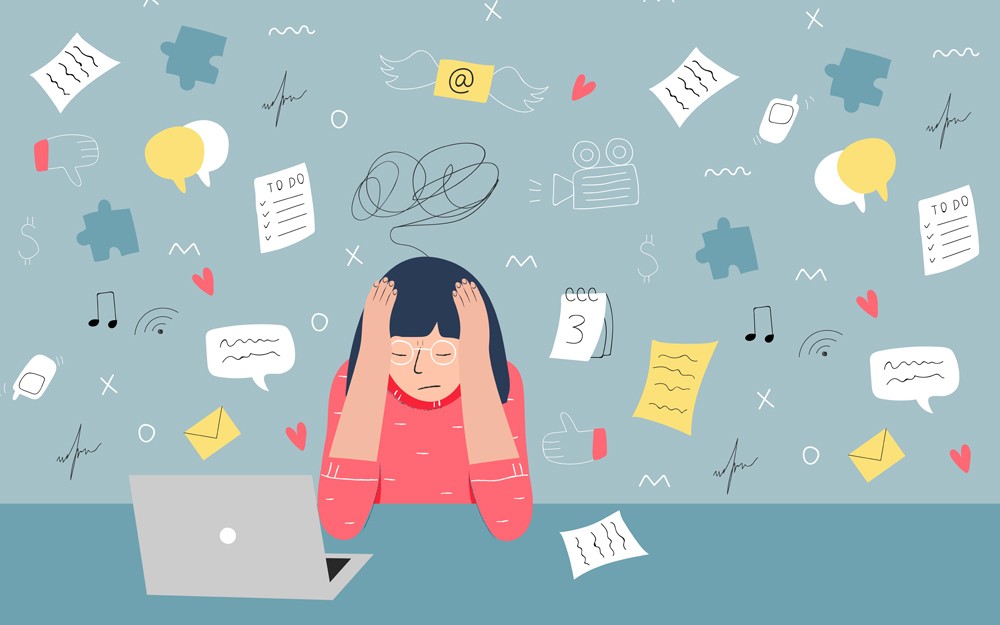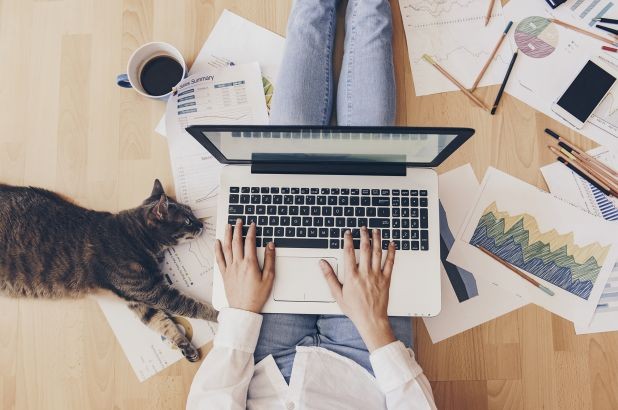Easy Ways To Return Back To Work Post Covid-19
After more than a year of remote work brought on by the COVID-19 pandemic, many employers are starting to reopen their offices—and workers have mixed feelings. Some relish the idea of collaborating with colleagues in-person and swapping their makeshift home office on their kitchen table for a dedicated workspace.
Return-to-office planning is ramping up and as many companies have experienced tremendous change in headcount over the past two years, the transition back to the office introduces the challenge of welcoming new team members and reorienting existing employees. While this is a positive sign for businesses, we know that it's a heavy lift to coordinate space, desks, and resources for new and returning workers.
1. Where is the stress coming from?
 |
| Photo: Swinburn |
It’s not weird to feel apprehensive about returning to work. According to Dr. Susan Albers, PsyD, Cleveland Clinic, it’s normal considering we’ve been safe in our pods for so long. If you’re worried, what you’re experiencing is called “reentry anxiety” and there are two forms of it.
“The first form concerns safety. People are anxious that when they leave their house, they may unknowingly contract COVID-19 or possibly spread it. The second type is around social interactions. Over the past year, we have been social distancing and lost practice of how to meet with people in person, look them in the eyes and engage in everyday chitchat.”
She adds that anxiety can be good in certain situations. But when it becomes too much, anxiety can be paralyzing.
“A little bit of anxiety is okay. It helps motivate you. For example, if you’re going to take a test, having a little bit of anxiety is helpful because it motivates you to study. Too much anxiety shuts you down and you become isolated. Sometimes, you can’t even function.”
2. How to start mentally preparing for the return to work
 |
| Photo: Jackie Chia dot Com |
Dr. Albers recommends walking through scenarios that you might encounter at work to help you feel more at ease. “Imagery is powerful in helping people to cope with anxiety-filled situations. When you do this, it’ll help you gear up emotionally.”
She also suggests doing a dry run before your official return to work date.
“Don’t jump right in. Put your toe in the water. Go back to your office before your official start date. Look around. Sit in your chair. Remember that a lot has changed in a year, so expect that things are not going to look or feel like they did a year ago.”
Tidy up
And while you’re there, you might as well spruce up your workspace.
“If your office has been vacant for a year, it may need some refreshing or cleaning. When you do your dry run, take some cleaning products with you and spend some time getting your space ready. Add some new pictures and make it look nice and pleasant. A pleasing, clean and organized environment is good for your mental health. Being in one can also help reduce your stress level, particularly your cortisol hormone level (the stress hormone).”
She adds that greening up your space might help, too.
“Bring a plant to work. Research indicates that plants help reduce stress levels at the office and increase productivity by 15%.”
Give your wardrobe a makeover
When you look good, you feel good. And while that salsa-stained sweatshirt and those well-worn leggings are comfy, you know that you stand a little taller and feel more confident when you’re wearing a sharp outfit.
Dr. Albers says there are even studies to show that work attire makes us feel more confident and professional. “The right wardrobe can help you transition back into your role. Consider buying a new outfit or refreshing your wardrobe a little by adding pieces that make you feel comfortable.”
Establish a better sleep schedule
Not having a commute made it easier for you to take a snooze cruise until a few minutes before you were scheduled to start your workday. On the other hand, managing family life might have pushed your workdays late into the night. Well, the good thing about going back to work is that you’ll have a normal day again. Make sure you’re well-rested so you’re not nodding off in those in-person meetings.
3. Be compassionate with yourself, and others
 |
| Photo: Getty Images |
The shift to home working was sudden, and that kind of change was psychologically jarring and therefore negative for most people, according to Meag-gan O’Reilly PhD, a psychologist at Stanford, cofounder of Inherent Value Psychology Inc. What’s more, this shift was combined with uncertainty about the future; the loss of autonomy, freedom and connection that came with lockdown; and a level of loss and grief that was unprecedented for many of us.
Being at home all the time and losing familiar structures and routines led some of us to overwork — which might have included taking up new hobbies with overly high expectations — while others struggled to focus. “If you pride yourself on having a good work ethic, that may have hit your sense of self and self-esteem,” O’Reilly says. “I think people were unfairly blaming themselves for struggling. When you’re going through something unprecedented, there’s no bar for this.”
The pandemic also highlighted existing inequalities. O’Reilly asks: “Who was getting the virus more? Black and brown communities, because they’re more likely to be essential workers that deal with people. So for people who are Black and brown, we had to sit and hold and deal with this history and this very present racism, sexism and classism.” At the same time, the murder of George Floyd and continued episodes of police brutality brought grief and trauma to the fore for so many and contributed to feelings of discomfort or othering at work, based upon how employers responded to the movement for Black lives.
Consider the things that have changed for you this year and decide what elements you want to keep.
Besides these huge societal issues were the minutiae — the cancelled holidays, birthdays over Zoom instead of in person, not being able to hug loved ones or even stop by a coworker’s desk to say “hello” in the morning. We lost or had to adjust the little daily routines that make up our lives, and as many of us are exiting crisis mode, it’s time to take stock of both what your life is like now and what it used to be like.
O’Reilly says it’s important to acknowledge the journey you’ve been on in the past 20 months and give yourself compassion and empathy. Consider the things that have changed for you this year, and decide what elements you want to keep.
“One of the elements I hope all of us keep as we return to work is this idea of shared humanity,” she says. “When we were all Zooming in, we had kids running in the background, our pets jumping up on our laps. People got to see us as more fully human, and that allowed everyone else to give more grace.”
4. Be intentional with your time and energy, and set realistic expectations
 |
| Photo: OSCE |
If a commute is part of your return to the office, your time is likely to be squeezed during this transition. “We need to accept that we can’t show up everywhere,” O’Reilly says. “Stretching and hustling and trying to be everywhere is not only futile, but it’s exhausting. And it’s trying to solve the wrong problem.”
Instead, she encourages people to think about what projects, teams, activities and individuals they want to be more connected with. How can you show up where you want to be? How are you going to distribute your finite energy and time intentionally? Are there certain things you’ve invested time or energy in that you want to continue? Or leave behind?
If you’re preparing to return to in-person work, you need to understand what it will look like. Companies are taking different approaches, but one thing’s certain, says US-based Rebecca Henderson, CEO of Randstad Global Businesses, which provides HR services. “We’re not going back to what it was pre-pandemic. There are going to be limitations on how people will be getting together.” This could mean that lunch break spaces, meeting rooms and even restrooms may look very different than before.
Another important consideration is vaccination. Not everyone will choose to be vaccinated, and companies will need to decide how to approach this. Get to know the reality you’re heading back into. What are the rules where you work? Are you comfortable with the safety measures your employer has established? Ask questions, and read the information provided by your workplace. Then imagine the situation and give yourself time to adjust to it mentally.
5. Set your boundaries
 |
| Photo: Shutterstock |
Working from home blurred a lot of boundaries. When you’re sitting at a makeshift desk in your bedroom or kitchen, it can be almost impossible to separate work from home. “You could be having dinner with your family, yet you’re still working,” says O’Reilly. “You’re more accessible – people can email you anytime, so the boundary gets lost.”
This shift back to the office gives you the chance to set your boundaries in terms of availability, communication and when and where you work. Do you want to turn off your emails at certain times? Do you prefer to communicate by Slack or video call? Are weekly check-in meetings most effective? Think about what works best for your productivity and your mental health, and share these findings with your employer and colleagues.
Prepare to take care of your mental health
It’s totally normal to plan for anxiety — after all, we do this all the time for big, anxiety-provoking events like weddings and births. O’Reilly recommends the following three steps: Pin down a date to return to the office, have an internal conversation about how you’re feeling, and talk to people about it. “Free-floating anxiety is worse than specific worries,” O’Reilly says. “Having an anchor date is grounding, so it’s not sudden or unknown. Asking yourself questions helps you attend to your feelings and adapt to the stressors.”
For example, if you identify that you’re anxious about attending a meeting, this might mean planning to sit at the back of the room. Talking to others — gathering a community — will give you support for managing your anxiety. But O’Reilly says it can go much further. “I think mental health got a big spotlight during this pandemic, finally, in a way that wasn’t as stigmatized, because we were all going through it,” she says. “I want people to know they’re not the only ones. We always do better when we don’t feel alone.”
 | Full Guide To Quy Nhon Beach Nha Trang is one of the most famous tourist destinations in Vietnam, and Quy Nhon beach, a well–known spot there, possesses a pristine and peaceful ... |
 | Post Covid-19 Physical Exercises: How To Exercise To Improve Your Health Exercise might be tough after being sick, especially in the Covid-19 case. Here is how you can exercise and improve your health for recovery. |
 | Post-Covid Diet: What To Eat For Quick Recovery Post Covid-19 care is critically important to people who have been sick because of the virus for a long time, as it heavily affects our ... |
Recommended
 Handbook
Handbook
Vietnam Moves Up 8 Places In World Happiness Index
 Handbook
Handbook
Travelling Vietnam Through French Artist's Children Book
 Multimedia
Multimedia
Vietnamese Turmeric Fish among Best Asian Dishes: TasteAtlas
 Handbook
Handbook
From Lost to Found: German Tourist Thanks Vietnamese Police for Returning His Bag
Popular article
 Handbook
Handbook
Prediction and Resolution for the Disasters of Humanity
 Handbook
Handbook
16 French Films To Be Shown For Free During Tet Holiday In Vietnam
 Handbook
Handbook
Unique Cultural and Religious Activities to Welcome Year of the Snake
 Handbook
Handbook







